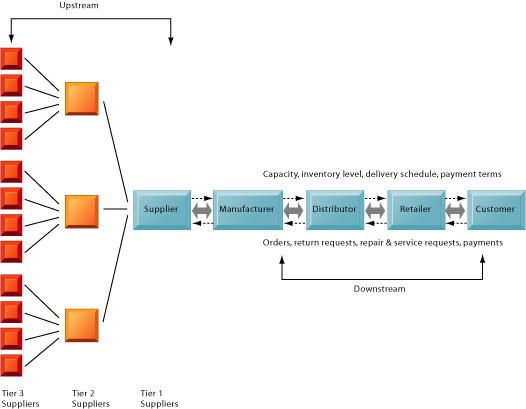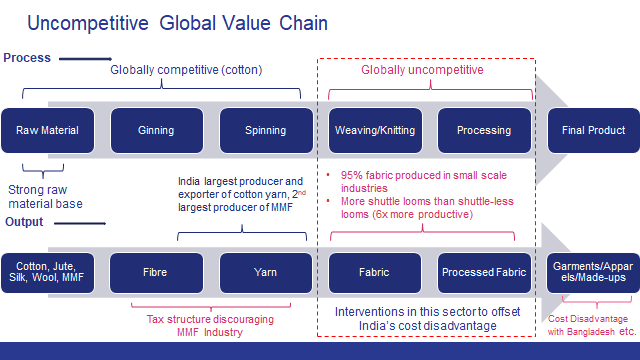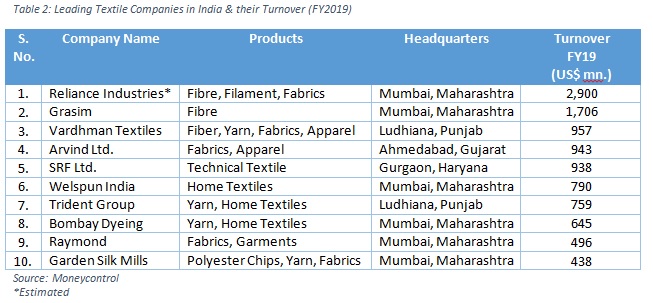Here Top 10 Reasons to Boost Textile and Apparel Sector in India. The Textile industry in India is one of the largest in the world. India is the world’s second-largest clothing and apparel manufacturer. The Indian textile and apparel industry is estimated to be worth US$ 142 billion, with domestic consumption accounting for 74% and exports accounting for 26%. Despite global uncertainty and a slowdown in demand, the sector in India has been rising in double digits over many years.
Wazir Advisors has been an active participant in the development of the sector as an adviser, a thought leader, and an implementation partner as a sector specialist consultant. We believe that the real growth process of industry is about to begin, based on economic fundamentals and recent technologies. Our confident attitude is based on a few fundamental reasons that are special to India. We discuss why India is on track to become a world leader in textile and apparel manufacturing, exports, and consumption in the near future in the overview below.
Here Top 10 Reasons to Boost Textile and Apparel Sector in India
1. Access to a Large Supply of Raw Materials
Indian has a strong raw material base that includes all forms of natural and synthetic fibres, which has helped it gain worldwide support. It is the world’s second largest cotton producer, responsible for nearly 21% of global cotton production. India is also the world’s second-largest polyester manufacturer. Another important textile fibers for which India is a big manufacturer is polyester blend.
 2. Participation in the Entire value chain
2. Participation in the Entire value chain
India is one of the few textile manufacturing countries in the world with a presence at every stage of the value chain, from fibre and fabric production to garment manufacturing.
3. Manufacturing Costs Which Are Competitive
Given the fact that India is not a low-cost manufacturing location, it remains competitive for a variety of reasons. India’s wage cost is higher than Bangladesh’s, but lower than China’s and Vietnam’s. India’s power costs are comparable to low-cost destinations such as Bangladesh, Vietnam, Myanmar, Kenya, and others, but higher than China’s.
Related Blog- How ERP Software can Assist you in Improving your Revenue?
4. Accessibility with Ready-to-use infrastructure
India has a long history of textile and apparel manufacturing, with infrastructure covering the country in various clusters. The following are some of the most important industry sectors:
SEZs (Special Economic Zones) are another form of support that helps textile and apparel exporters compete on a world basis. The establishment of Centers of Excellence (CoEs), R&D facilities, and other primary infrastructure resources for the textile industry’s growth are also supported by the Indian central and state governments.
5. Access to a Large Team of Talent and English Speaking Personnel
With 65 percent of its population under the age of 35, India has the world’s largest youth population. In the near future, India’s demographic dividend would allow it to lead as a manufacturer of labor-intensive products such as textiles and apparel. With a greater focus on efficiency, the demand for skilled labour is expected to increase in the near future. As a result, the Indian government has taken steps to build a man power pool in the country.
6. A large and Expanding Domestic Market
In 2019-20, India’s domestic textile and apparel consumption is estimated to be worth US$ 106 billion. Apparel retail accounts for US$ 74 billion, technological textiles for US$ 17.4 billion, and home textiles for US$ 6.2 billion.
 7. Government Benefits
7. Government Benefits
To help textile and apparel manufacturers compete on a world basis, the Indian government has launched a number of support schemes. The programmes are designed to improve technology, developing infrastructure, and promoting exports, among many other things. Rebate of State and Central Taxes and Levies (RoSCTL), Amended Technology Upgradation System (ATUFS), and other schemes are one of them.
8. Access to Specific Markets with Preference
Under 15 trade deals, India has preferential market access to 43 countries. The following are some of the main agreements:
India, Pakistan, Nepal, Sri Lanka, Bangladesh, Bhutan, Afghanistan, and the Maldives are members of the South Asia Free Trade Area (SAFTA). Bangladesh, China, India, Republic of Korea, Lao People’s Democratic Republic, Sri Lanka, and Mongolia are members of the Asia-Pacific Trade Agreement (APTA).
The presence of large integrated players.
The presence of large scale manufacturers throughout the value chain, from yarn to finished products, defines the Indian textile industry. These large textile corporations have large production capacities, compliant set-ups for high-quality products manufacturing, and are well-known by international buyers.
Also Read- 4 Steps to Choose the Right Distribution Software for Your Business
The Following are Some of India’s largest Garment and Apparel Companies to Boost Textile and Apparel Sector :

10. Stability throughout the social, political, and social factors
India is a land of different cultures, with multiple cultures and religions living side by side. The country has approximately 22 official languages. It is the world’s largest democracy, with a strong and increasing middle class. With a median age of 27 years, India has the world’s largest generation population. Almost half of India’s population is under the age of 25, which means they will soon enter the workforce and add to the country’s growing buying power. In terms of education and literacy growth, Countries have made significant progress and change, and it has been one of the major contributors to its economic development.





